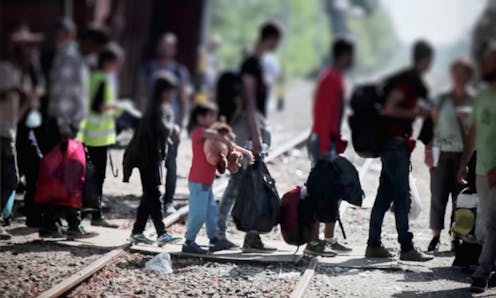Community members should be able to sponsor refugees for the right reasons, not to save the government money
- Written by Anthea Vogl, Lecturer, University of Technology Sydney

This week the Greens announced their refugee policy. It includes allowing private citizens to sponsor refugees as part of its plan to increase Australia’s humanitarian intake by 10,000. In December, Labor also announced plans to increase the existing community sponsored refugee program by up to 5,000 places per year.
Australia’s little-known community support program (CSP) allows individuals, businesses or community organisations to fund and sponsor the travel and resettlement of refugees into Australia from overseas.
But the number of visas allowed under the CSP is part of the overall quota in Australia’s humanitarian program. This means that, for each refugee sponsored privately, one less place is available in the government-funded resettlement program.
The CSP also requires the sponsored refugee to be capable of getting a job quickly and have functional English. Altogether, this suggests the CSP seeks to exploit the goodwill of the community while shifting the cost of resettlement away from the government.
Community sponsorship of refugees in Australia
The history of community involvement in refugee sponsorship dates back to the community refugee resettlement scheme. The program ran from 1979 to 1997 and resettled more than 30,000 refugees, primarily from Vietnam.
Australia’s current program began with the community proposal pilot in 2013. This provided 500 places, again from within Australia’s refugee and humanitarian program (which has a capped quota for each financial year). This meant the overall humanitarian intake didn’t increase under the pilot, but the government did save money. Community sponsors covered the cost of existing resettlement places for the first year as well as paying significant visa fees.
Read more: Private resettlement models offer a way for Australia to lift its refugee intake
The government conducted a public consultation and review of the program in 2015. While it never publicised the findings of that consultation, documents obtained under Freedom of Information show 13 out of 17 respondents recommended the program should operate in addition to the existing refugee and humanitarian program. The responses also showed there was a perception the program was merely a “cost cutting scheme”.
The community support program was introduced in 2017 after the summit on refugees held in New York at the end of 2016. At the summit, then Prime Minister Malcolm Turnbull announced that
in addition to our existing programs, Australia will… create new pathways for refugees to resettle in Australia through the establishment of 1,000 places under a Community Support Program, where communities and businesses can sponsor applications and support new arrivals, leading to better settlement outcomes.
But rather than being “in addition”, the CSP again takes places from Australia’s existing refugee and humanitarian program, currently capped at 18,750 per year.
The CSP also introduced a number of new requirements. These include that refugees must have “adequate English”, be aged between 18-50 and “have a job offer or skills to enable you to get a job quickly”. Such requirements prioritise the country’s economic priorities over humanitarian need.
The 2017-18 budget promoted the CSP as a way for the government to raise A$26.9 million. This revenue gain comes from the extraordinarily high fees associated with the program. Altogether, the fees amount to more than A$100,000 to sponsor a refugee family of five.
What is the community saying?
Governments all over the world are looking at ways to increase community involvement in resettling refugees. Canada has been running a program that has facilitated the private sponsorship of more than 300,000 refugees since 1978.
Our unpublished research shows that Australian community members are eager to sponsor and support refugees to settle in Australia. But the current program is expensive, restrictive and does not expand Australia’s resettlement numbers. These problems have dissuaded community groups from getting involved.
Read more: FactCheck: is this the greatest period of humanitarian need since WWII?
A coalition of refugee and community organisations has formed the Community Refugee Sponsorship Initiative (CRSI). This calls on the government to develop a new sponsorship model “to enable people to come together to add to, not reduce, Australia’s resettlement places”.
They have collected the names of more than 13,000 community members who would sponsor refugees should the current model be reformed.
The CSP can expand our refugee program
Both the Greens’ and Labor’s policies pledge that the number of people coming to Australia under refugee sponsorship will be in addition to those under the humanitarian program. They also propose to abolish the problematic requirements that undermine the humanitarian principle of refugee resettlement.
To date, the CSP has been largely used by people living in Australia as a form of family reunion. This is because other safe pathways for families to be reunited have been closed off or limited by the government.
More than 90% of the 1,000 refugees resettled through the current CSP have been sponsored by family members, rather than the wider community. The CSP is also limited to refugees from the Democratic Republic of Congo, Afghanistan, Eritrea, Ethiopia, Myanmar, Bhutan, Syria and Iraq, with a significant majority coming from Syria and Iraq.
Private sponsorship will continue to function as an expensive form of family reunion until better options are made available.
Community sponsorship of refugees has the potential to transform refugee resettlement. It can significantly expand the scale of Australia’s humanitarian migration program, allowing the public to supplement the government-funded humanitarian migration program. This means more refugees finding safety every year, when other resettlement programs (such as that in the US) are shrinking.
When done properly, community sponsorship engages the broader community in the resettlement of refugee arrivals. It can challenge and rewrite government-led narratives about refugees and asylum seekers.
Authors: Anthea Vogl, Lecturer, University of Technology Sydney





